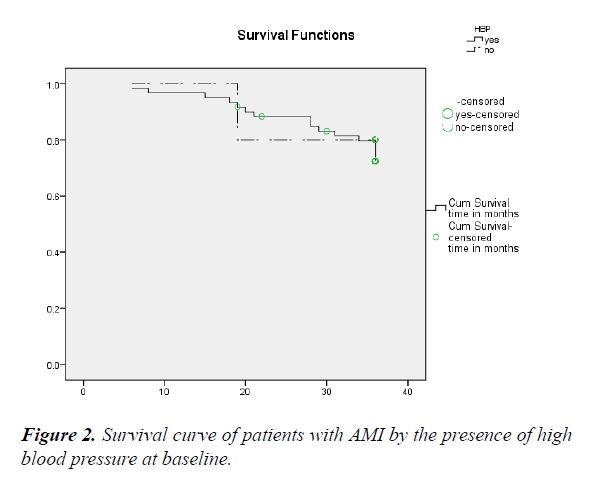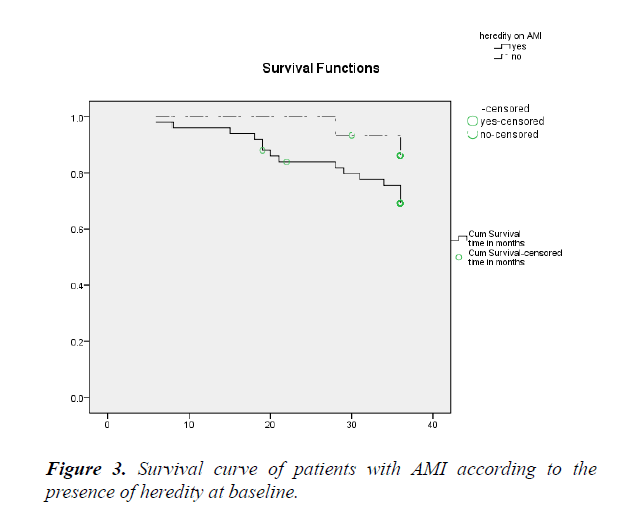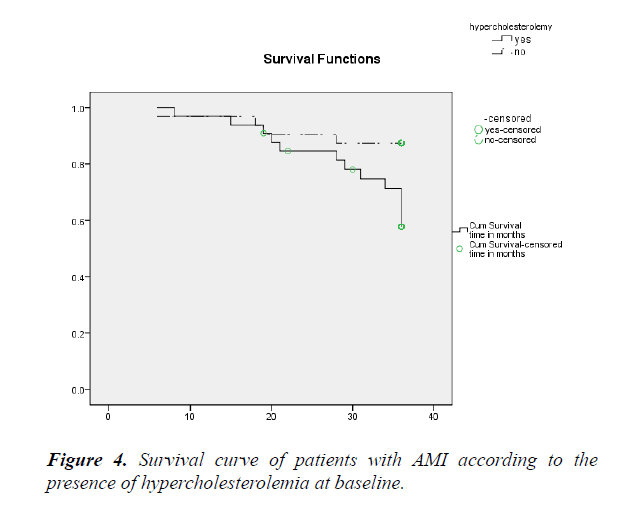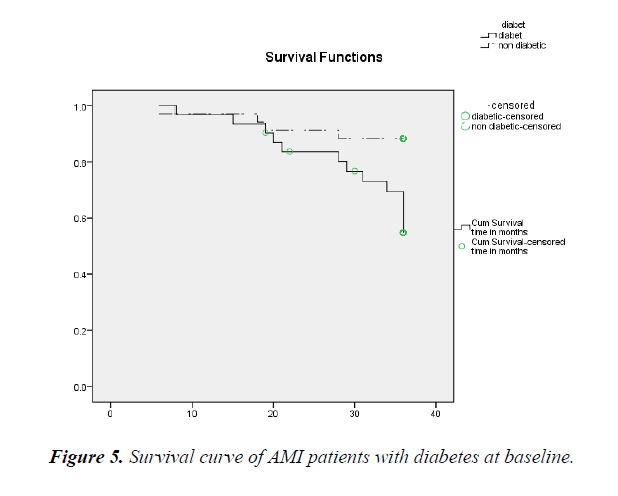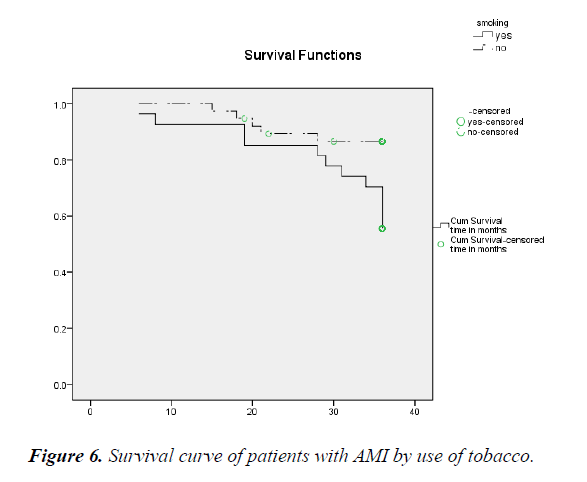Research Article - Journal of Pharmacology and Therapeutic Research (2018) Volume 2, Issue 2
Survival of the patients after the first episode of AMI according to the risk factors
Brunilda Elezi*
University of Elbasan Aleksander Xhuvani, Faculty of Technical Medical Sciences, Elbasan, Albania
- *Corresponding Author:
- Brunilda Elezi
University of Elbasan Aleksander Xhuvani
Faculty of Technical Medical Sciences
Elbasan, Albania
E-mail: brunildaxibraku@hotmail.com
Accepted on June 06, 2018
Citation: Elezi B. Survival of the patients after the first episode of AMI according to the risk factors. J Pharmacol Ther Res 2018;2(2):10-13.
DOI: 10.35841/pharmacology.2.2.10-13
Visit for more related articles at Journal of Pharmacology and Therapeutic ResearchAbstract
Introduction: The term “risk factors” describe those characteristics that are found in healthy persons that are connected in an independent way with the occurrence of the associated cardiovascular disease. This term includes the lifestyle, biochemical and physiological modified characteristics, and also the personal unmodified characteristics such as: age, gender, and family history in the occurrence of cardiovascular disease in the early age (male<55 year’s old, female<65 years old).
Aim: Evaluation of predictive ability of risk factors of patients at the moment of the hospitalization in long-term prognosis of the patients with a new myocardial infarct, during the progression of 3 years of the patients after a new episode of myocardial infarct in the Elbasan region.
Methodology: It is a cohort study for a period of 3 years, to value the prognostic abilities of the clinical characteristics of the patients in the moment of hospitalization in undesired results in long-term like the new occurrence of the infarct. To assess the effect of risk factors of cardiovascular disease in the occurrence or not in an another episode of AMI, we used the analysis curve of survival Kaplan Meier in the SPSS 16. A p<0.05 is considered significant.
Results: From 65 patients involved in the study, at the end of the study period, 16 of them had had an interest events (death/reinfarct) that is a significant way lower than its non-repeating (p<0.05). Change in the level of survival of individuals with AMI according to the presence or not the high blood pressure, according to the family history, use or not tobacco for the AMI is not statistically significant (Log Rank p>0.05). Changes in the level of survival of individuals according to the cholesterol level normal or high, presence or not of the diabetes has changes in the statistics (Log Rank p<0.05).
Conclusion: Knowledge of the risk factors that are also a prognosis factor of the patient performance with AMI helps in defining patients that needs to undergo a more specific check-up to avoid these undesired results. The reason that patients has been smokers, have, hypercholesterolemia history are at a higher risk to have a reserved prognosis of the disease (recurrence of myocardial infarct or death). Knowledge of this group would help in composition of personalized pursuance of the patients trying to reduce chances of the repeating of AMI and elimination in the time the recurrence of AMI.
Keywords
Risk factors, Acute myocardial infarction, The long-term prognosis, Survival
Introduction
The term “risk factors” describe those characteristics that are found in healthy persons that are connected in an independent way with the occurrence of the associated cardiovascular disease. This term includes the lifestyle, biochemical and physiological modified characteristics, and also the personal unmodified characteristics such as: age, gender, and family history in the occurrence of cardiovascular disease in the early age (male<55 years old, female<65 years old).
Overall, the concept of risk factors poses a major advantage to the development of strategies for the prevention of coronary diseases [1-10].
The study included 65 patients with AMI (new episode the AMI). 16 patients or 24.6% had a recurrent AMI during the study years.
Methodology
The study is designed as a cohort study for a three year period from 2009-2012. The study included patients that were admitted to the Elbasan hospital and treated for the new AMI during 2009.
They are taken in pursuit patients that have both residential district center of Elbasan. The study was performed partly in the regional hospital in Elbasan near the cardiology pavion and partly in the health centers of the city of Elbasan (part of cohort study).
The presence of risk factors was taken according to the cardiac history in relation to: The use of tobacco until hospitalization (smoking was defined as a dichotomous variable whether or not). The presence of high arterial precision regardless of medication or not (defined as dichotomous variable yes or no).
The presence of coronary artery disease. A previous coronary artery disease in quality of ischemic heart disease different from AMI (obtained from the Medical file). After a history of diabetes as taken from the patient (dichotomous variable yes/ no). High values of hyperlipidemia (according to anamnesis if the individual gets or does not treat hyperlipidemia). Family heredity about the occurrence of AMI in the family (mother/ father or sibling/brother), defined as dichotomous variable yes or no).
The effect of the risk factors of the survival of patients with AMI was estimated at technique of Kaplan Mayer on the SPSS 16. A p<0.05 is considered significant.
Results
Study included 65 patients with AMI (new episode of AMI). One in five patients were female (or 21.5%), presenting a significant difference and statistically significant compared to the men (78.5%) (On chi square p<0:05).
Table 1 provides data on the average age of patients and the standard deviation. The minimum age of a myocardial infarction is 48 years and maximum 85 years.
| Average ± SD | Minimum | Maximum | |
|---|---|---|---|
| Age (years ) | 66.4 ±1.6 | 48 | 85 |
Table 1. Average age of the patients with new AMI
As indicated on in the graphic (Figures 1-6) at the end of three-year study period, 65 patients were included in the study, about 16 (25%) of them had have an event of interest (re-myocardial infarction) which significantly is most lower than his repeating of event (75%) (chi square, p<0:05).
In Table 2 are presented the characteristics of the sample of relation of the risk factors for the occurrence of acute myocardial infarction. Patients hospitalized and survived after an attack of myocardial infarction in 92.3% of cases refer reasonably have been diagnosed with high blood pressure. Diabetes and high levels of cholesterol found in almost half the patients involved in the study and 4 to 5 refer patients have no family history of acute myocardial infarction. In most cases (about 70%), patients refer to being diagnosed with coronary artery disease and statistically significantly higher. Regarding lifestyle factors, in almost 38.5% of cases, patients reporting smoking use up to the moment of myocardial infarction, and in 67.7% of cases, patients are obese.
| The variable | n | % | P value * |
|---|---|---|---|
| Presence of High blood pressure | 60 | 92.3 | <0.01 |
| Presence of diabetes | 31 | 47.7 | 0.17 |
| Presence of hypercholesterolemia | 33 | 50.2 | 0.9 |
| Presence of family history for AMI | 50 | 79.6 | 0.15 |
| Previous artery coronary disease | 45 | 69.2 | 0.02 |
| Use of tobacco | 25 | 38.5 | 0.65 |
| Overweight / obesity | 44 | 67.7 | 0.04 |
*chi square
Table 2. Distribution of risk factors in subjects who have passed the AMI.
Results presented by Kaplan Meier survival analysis to determine the impact of risk factors for cardiovascular disease in the occurrence or not of another episode of AMI
Survival is higher in individuals that who not had high systolic blood pressure at the time of entry into the hospital than in individuals who have had arterial systolic pressure. The change in the survival rate of individuals by presence or wash arterial pressure does not change statistically (Log Rank p>0.05).
Survival is higher for individuals who did not have a family history for AMI at the time of hospital admission than in individuals who had family history for AMI. The change in the survival rate of individuals according to family history for AMI does not change statistically (Log Rank p>0.05).
Survival is higher in individuals who did not have high levels of cholesterol in the bloodstream when entering the hospital than in individuals who had high levels of cholesterol in the bloodstream. Changes in the survival rate of individuals by high or normal cholesterol levels are statistically significant (Log Rank p<0.05).
Survival is higher in individuals who are not diganosticated as diabetic at the time of hospital admission than in individuals who have diabetes in their history. Changes in the survival rate of individuals according to the presence or not of diabetes are statistically significant (Log Rank p<0.05).
Survival is higher for individuals who have not been smoking users in the hospital than in individuals who have been smoking users. Changes in the survival rate of individuals by use of non-smoking do not change statistically (Log Rank p>0.05).
Discussion
In our best knowledge this is the first study that attempted to identify the risk factors on the survival of the patients after an episode of AMI and to prepare the foundation for further advance studies. Risk factors for cardiovascular disease have different effects on the progress of patients with AMI during the first years after the first episode of AMI. Knowing the risk factors that are and prognostic factors in the progress of patients with AMI helps determine who should undergo a more specific control to avoid these undesirable results. Patients who are smoking users at the time before the AMI episode are more likely to have an unsuccessful outcome compared to patients who have not been smoking users. This finding is consistent with other studies conducted where smoking is defined as a defective prognosis determinant [11,12]. High blood pressure and heritage are not prognostic factors in the progress of patients. This may be related to the fact that high blood pressure has been found in most patients who have had an AMI episode and have been undergoing treatment but are in line with the conclusions of other studies conducted in Brazil [10,12,13]. Contrary to another study underlining the fact that high blood pressure is a risk factor for undesirable results during the AMI episode [14,15]. This diversity can be linked to the methodology of study and selection of the sample. One of the most prognostic factors is hypercholesterolemia. Patients who have had high cholesterol levels are more likely to have recurrent AMI episodes during their course. This is related to the fact that high levels of cholesterol affect the performance of improving cardiac muscle function by increasing its susceptibility to a future episode of cardiovascular or myocardial infarction [12]. Even diabetes is another important factor that affects the performance of patients. The results of our study are consistent with other studies that consider diabetes as a significant factor [9,10,12-13].
Conclusions and Recommendations
Knowledge on risk factors present on admission may improve the long-term prognosis of patients. This is because patients who have been smoking, diabetes, history of hypercholesterolemia are at risk for having the poorer prognosis of the disease (re-occurrence of myocardial infarction or even death). So among the known risk factors for cardiovascular disease, the strongest prognostic factors for the long-term performance of patients who have had an AMI episode are the use of tobacco and the presence of diabetes and hypercholesterolemia. This is a finding consistent with the findings of the Framingham study [9,12]. Presence in the history of patients who have had an episode of myocardial infarction puts these patients in a no favourable prognosis regarding the progression after the episode of acute myocardial infarction.
References
- The World heart Association. Atlas of Heart disease and stroke. 2005.
- Grundy SM, Balady GJ, Criqui MH et al. Primary Preventation of Coronary Heart disease: Guidance from Framingham. A statement for Healthcare Professionals from the AHA task Force on risk Reduction. Circulation 1998;97(18):1876-1887.
- Rossi E. Prevalence of cardiovascular risk factors in a contingency with coronary artery disease in Patient Cardiology. Clinic QSUT Tirana. 2002.
- Tase M. Risk factors of coronary atherosclerosis. education course for cardiovascular risk factors and ischemic heart disease for general practitioners of the Albanian ambulatory service. Project 2014-2016.
- Obesity management. J Europian Society Cardiology. 2005.
- Guidance from Framingham the AHA task Force on Risk Reduction, circulation 1998;97:1876-1887.
- The guide Albanian Association of Cardiology for Prevention of Atherosclerotic Cardiovascular Diseases in Clinical Practice. Albanian Cardiology J. 2006;5(1).
- Estemated prevalence of myocardial infarction and ischemic stroke comulated in 14 countries: Belgium, Canada, Danimark, Finland, Germany, France, Italy, Natherlands, Norway, Spain, Sweden, Switzerland, UK, USA. Guillat F, Monlard O. Circulation 1998; 98 (abstract suppl (1):1421.
- Jernberg T, Hasvold P, Henriksson M, et al. Cardiovascular risk in post-myocardial infarction patients: nationwide real world data demonstrate the importance of a long-term perspective. Eur Heart J. 2015;36(19): 1163-1170.
- Kumbhani DJ. Predictive models for short- and long-term adverse outcomes following discharge in a contemporary population with acute coronary syndromes. Am J Cardiovasc Dis. 2013;3(1):39-52.
- Montalescotl G. STEMI and NSTEMI: are they so different? 1 year outcomes in acute myocardial infarction as defined by the ESC/ACC definition (the OPERA registry). Eur Heart J. 2007;28(12):1409-1417.
- Rea TD, Heckbert SR, Kaplan RC, et al. Smoking status and risk for recurrent coronary events after myocardial infarction. Ann Intern Med. 2002;137(6):494-500.
- Herlitz J, Bang A, Karlson BW. Five-year prognosis after acute myocardial infarction in relation to a history of hypertension. Am J Hypertens. 1996;9:70-76.
- Wong ND, Cupples LA, Adrian M, et al. Risk factors for long-term coronary prognosis afterInitial myocardial infarction: the Framingham study. Am J Epidemiol. 1989;130(3):469-480.
- Pepine CJ, Kowey PR, Kupfer S, et al. Predictors of adverse outcome among patients with hypertension and coronary artery disease. J Am Coll Cardiol. 2006;47:547-551.

